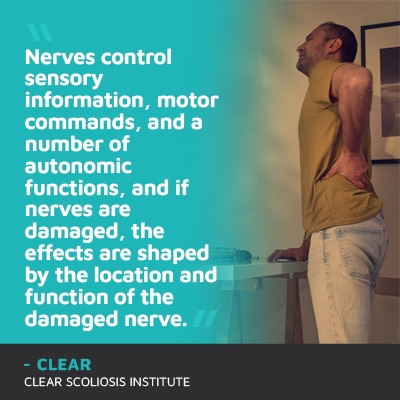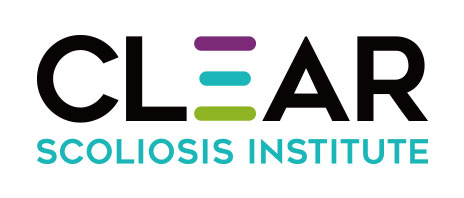
The brain and spinal cord make up the central nervous system: a vast communication network that facilitates brain-body communication, and the peripheral nervous system is divided into the somatic nervous system and the autonomic nervous system. The health of the nerves within these systems can affect brain-body communication, movement, sensation, walking, breathing, and digestion.
Both radiculopathy and neuropathy involve damaged nerves, but the location of the damaged nerves differentiates them. Radiculopathy refers to nerve damage that occurs in a nerve root, where it exits the spine, and neuropathy refers to damaged peripheral nerves that aren't located in the brain and spine.
Nervous system disorders like radiculopathy and neuropathy can affect the body in a number of ways, so let's start by exploring the different types of nerves.
Nerves are communication pathways that carry signals and information throughout the body, and there are different types of nerves that control different functions.
Ganglia refers to clusters of nerve cell bodies that aren't located within the central nervous system (CNS).
There are 12 pairs of cranial nerves that facilitate communication between the head, face, neck and brain, and there are 31 pairs of spinal nerves that extend from the spinal cord, within the spinal column, to the rest of the body.
Nerves are like branches of a tree, projecting into multiple different directions, which is why a damaged nerve can cause pain and a number of symptoms felt far from its original source, and this can also make nervous system disorders difficult to diagnose.
For example, pain that radiates into the extremities is a common symptom of compressed spinal nerves, and a number of sensations and muscle weakness can also develop.

Radiculopathy refers to one or more damaged nerves causing functional deficits and is commonly referred to as a pinched nerve.
Radiculopathy involves damage to a nerve root, where it exits the spine and branches off throughout the body, and as it involves nerve roots, this involves the spinal nerves and affects the central nervous system.

Common symptoms can include back pain, numbness, tingling, and muscle weakness, and the location of a damaged nerve will determine where the majority of its effects will be felt.
For example, the sciatic nerve is the largest in the body and starts in the lumbar spine, extending down the lower back, hip, buttock, leg, and into the foot.
If the sciatic nerve is compressed, symptoms of lumbar radiculopathy can be felt in the lower back and throughout the lower body.
What is Neuropathy?
Neuropathy refers to damaged nerves in the peripheral nervous system, and these nerves are located outside of the brain and spinal cord (central nervous system).
The peripheral nervous system (PNS) controls sensations, a number of movements, reflexes, and conscious/unconscious functions such as walking, breathing, and digestion.
The peripheral nervous system can be further divided into the somatic and autonomic nervous systems.
The somatic nervous system controls voluntary functions and skeletal muscles involved in walking, writing, and speaking, and the autonomic nervous system controls involuntary functions such as heart rate and digestion and connects the brain and spinal cord to internal glands and organs like the heart and lungs.
So peripheral neuropathy means nerves in the peripheral nervous system are damaged and unable to function optimally.
For patients recently diagnosed with radiculopathy or neuropathy, a common question is how bad the damage is and if it's reversible, and there are a number of factors that determine the answer.
Nerve damage can be permanent, or damaged nerves can heal over time, but this is shaped by the cause of the nerve damage, its severity, experienced symptoms, nerve location/function, and how long it's left untreated.
The severity of nerve damage refers to whether a nerve is cut, stretched, or bruised; a complete cut is more difficult to heal from and is more likely to be permanent.
The more disruptive a patient's symptoms are, the worse the nerve damage is, so for patients experiencing intense and chronic nerve and/or radiating pain, permanence is more likely.
Location of the nerve is also important; the nerves of the central nervous system aren't typically regenerative, while the peripheral system nerves can regenerate after injury and damage.
Nerve damage caused by an underlying medical condition is more likely to be severe and/or permanent, and there are a number of conditions capable of causing radiculopathy and/or neuropathy.
If an underlying medical condition like diabetes is causing diabetic neuropathy, the diabetes itself needs to be managed to improve its impact on nerve function. Diabetic neuropathy can be severe as damage can increase over time with blood-sugar fluctuations.
How long a nerve has been exposed to uneven pressure is a key factor, and this is where early detection and intervention can help increase treatment efficacy; duration of pressure is important as short-term pressure is easier to reverse and heal from than chronic pressure occurring over long periods of time.
Scoliosis is another condition capable of causing nerve compression as it causes the spine to bend and rotate unnaturally, exposing the spinal nerves within to compression once growth stops, and as a progressive condition, its effects can increase over time.
Bone spurs are overgrowths of bone that form on the edges of bones, or in the joints where bones meet, and can also cause nerve compression, inflammation, and/or impingement by encroaching on nerve-space.
There are a number of underlying medical conditions capable of causing radiculopathy and/or neuropathy, and when a chronic condition is present, permanent nerve damage is more likely, particularly if the condition is left untreated or not treated proactively.
Key facts to know about radiculopathy and neuropathy are that both conditions involve damaged nerves, and the location of nerves affected differentiate the nervous system disorders.
While radiculopathy refers to damaged nerve roots of the central nervous system, neuropathy refers to damaged nerves in the peripheral nervous system.
The central nervous system consists of the brain and spinal cord and acts as the body's control center regulating brain-body communication, processing sensory input, generating responses, and coordinating complex movements.
The central nervous system works in conjunction with the peripheral nervous system as the PNS transmits information from the body to the brain and spinal cord and carries commands from the CNS to the rest of the body.
Damaged nerves can be difficult to diagnose because their symptoms can be so widespread throughout the body. For example, spinal compression caused by an unnatural spinal curve, like scoliosis, can cause radiating pain into the arms, legs, hands and feet.
The first step to addressing nerve damage is determining the affected nerve's location and cause, and while pain medications can help alleviate symptoms, the cause of uneven pressure has to be addressed for any type of long-term pain relief.
Relieving pressure on a compressed nerve and/or nerve root can involve chiropractic adjustments and physical therapy, and prioritizing spinal health can help preserve the health of the nerves within.
Here at the CLEAR Scoliosis Institute, preserving spinal health is the focus of diagnosing and treating scoliosis proactively, and when it comes to the potential effect of nerve compression, the sooner treatment is started, the better.

CLEAR provides a unique and innovative way of understanding scoliosis. Sign up to receive facts and information you won’t find anywhere else.
